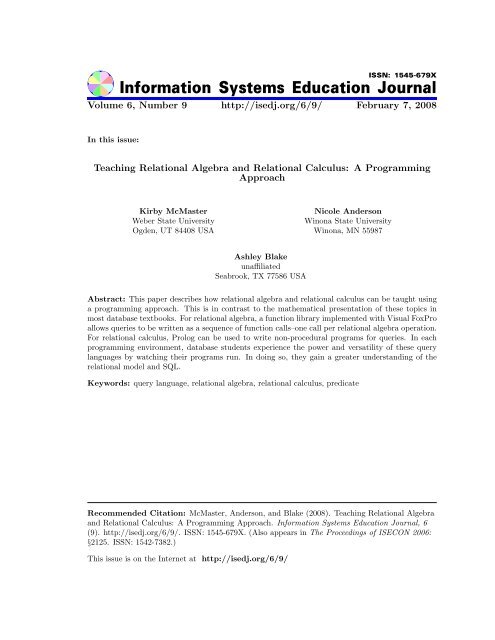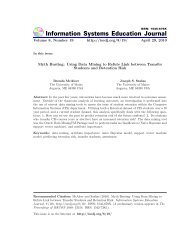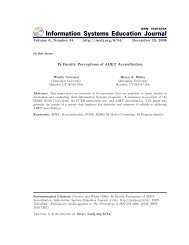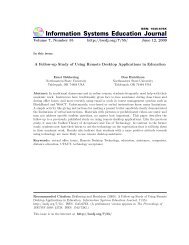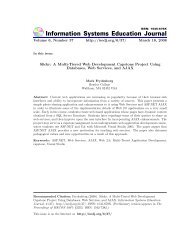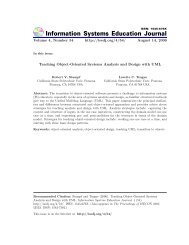Teaching Relational Algebra and Relational Calculus: A ...
Teaching Relational Algebra and Relational Calculus: A ...
Teaching Relational Algebra and Relational Calculus: A ...
You also want an ePaper? Increase the reach of your titles
YUMPU automatically turns print PDFs into web optimized ePapers that Google loves.
Volume 6, Number 9 http://isedj.org/6/9/ February 7, 2008<br />
In this issue:<br />
<strong>Teaching</strong> <strong>Relational</strong> <strong>Algebra</strong> <strong>and</strong> <strong>Relational</strong> <strong>Calculus</strong>: A Programming<br />
Approach<br />
Kirby McMaster<br />
Nicole Anderson<br />
Weber State University<br />
Winona State University<br />
Ogden, UT 84408 USA Winona, MN 55987<br />
Ashley Blake<br />
unaffiliated<br />
Seabrook, TX 77586 USA<br />
Abstract: This paper describes how relational algebra <strong>and</strong> relational calculus can be taught using<br />
a programming approach. This is in contrast to the mathematical presentation of these topics in<br />
most database textbooks. For relational algebra, a function library implemented with Visual FoxPro<br />
allows queries to be written as a sequence of function calls–one call per relational algebra operation.<br />
For relational calculus, Prolog can be used to write non-procedural programs for queries. In each<br />
programming environment, database students experience the power <strong>and</strong> versatility of these query<br />
languages by watching their programs run. In doing so, they gain a greater underst<strong>and</strong>ing of the<br />
relational model <strong>and</strong> SQL.<br />
Keywords: query language, relational algebra, relational calculus, predicate<br />
Recommended Citation: McMaster, Anderson, <strong>and</strong> Blake (2008). <strong>Teaching</strong> <strong>Relational</strong> <strong>Algebra</strong><br />
<strong>and</strong> <strong>Relational</strong> <strong>Calculus</strong>: A Programming Approach. Information Systems Education Journal, 6<br />
(9). http://isedj.org/6/9/. ISSN: 1545-679X. (Also appears in The Proceedings of ISECON 2006:<br />
§2125. ISSN: 1542-7382.)<br />
This issue is on the Internet at http://isedj.org/6/9/
ISEDJ 6 (9) Information Systems Education Journal 2<br />
The Information Systems Education Journal (ISEDJ) is a peer-reviewed academic journal<br />
published by the Education Special Interest Group (EDSIG) of the Association of Information<br />
Technology Professionals (AITP, Chicago, Illinois). • ISSN: 1545-679X. • First issue: 8 Sep 2003.<br />
• Title: Information Systems Education Journal. Variants: IS Education Journal; ISEDJ. • Physical<br />
format: online. • Publishing frequency: irregular; as each article is approved, it is published<br />
immediately <strong>and</strong> constitutes a complete separate issue of the current volume. • Single issue price:<br />
free. • Subscription address: subscribe@isedj.org. • Subscription price: free. • Electronic access:<br />
http://isedj.org/ • Contact person: Don Colton (editor@isedj.org)<br />
2007 AITP Education Special Interest Group Board of Directors<br />
Paul M. Leidig<br />
Gr<strong>and</strong> Valley State Univ<br />
Past President 2005-2006<br />
Patricia Sendall<br />
Merrimack College<br />
Secretary 2007<br />
Don Colton<br />
Brigham Young Univ Hawaii<br />
EDSIG President 2007<br />
Kenneth A. Grant<br />
Ryerson University<br />
Treasurer 2007<br />
Robert B. Sweeney<br />
Univ South Alabama<br />
Vice President 2007<br />
Wendy Ceccucci<br />
Quinnipiac University<br />
Member Services 2007<br />
Thomas N. Janicki<br />
Univ NC Wilmington<br />
Director 2006-2007<br />
Gary Ury<br />
NW Missouri St<br />
Director 2006-2007<br />
Albert L. Harris<br />
Appalachian State Univ<br />
JISE Editor<br />
Valerie J. Harvey<br />
Robert Morris Univ<br />
Chair ISECON 2007<br />
Ronald I. Frank<br />
Pace University<br />
Director 2007-2008<br />
Kathleen M. Kelm<br />
Edgewood College<br />
Director 2007-2008<br />
Alan R. Peslak<br />
Penn State<br />
Director 2007-2008<br />
Information Systems Education Journal 2006-2007 Editorial <strong>and</strong> Review Board<br />
Don Colton<br />
Brigham Young Univ Hawaii<br />
Editor<br />
Thomas N. Janicki<br />
Univ of North Carolina Wilmington<br />
Associate Editor<br />
Samuel Abraham<br />
Siena Heights Univ<br />
Janet Helwig<br />
Dominican Univ<br />
D. Scott Hunsinger<br />
Appalachian State Univ<br />
Terri L. Lenox<br />
Westminster College<br />
Doncho Petkov<br />
Eastern Connecticut St U<br />
Belle S. Woodward<br />
Southern Illinois Univ<br />
Steve Reames<br />
Angelo State Univ<br />
Charles Woratschek<br />
Robert Morris Univ<br />
Michael Alan Smith<br />
High Point University<br />
Peter Y. Wu<br />
Robert Morris Univ<br />
EDSIG activities include the publication of ISEDJ, the organization <strong>and</strong> execution of the annual<br />
ISECON conference held each fall, the publication of the Journal of Information Systems Education<br />
(JISE), <strong>and</strong> the designation <strong>and</strong> honoring of an IS Educator of the Year. • The Foundation for<br />
Information Technology Education has been the key sponsor of ISECON over the years. • The<br />
Association for Information Technology Professionals (AITP) provides the corporate umbrella under<br />
which EDSIG operates.<br />
c○ Copyright 2008 EDSIG. In the spirit of academic freedom, permission is granted to make <strong>and</strong><br />
distribute unlimited copies of this issue in its PDF or printed form, so long as the entire document<br />
is presented, <strong>and</strong> it is not modified in any substantial way.<br />
c○ 2008 EDSIG http://isedj.org/6/9/ February 7, 2008
ISEDJ 6 (9) McMaster, Anderson, <strong>and</strong> Blake 3<br />
<strong>Teaching</strong> <strong>Relational</strong> <strong>Algebra</strong> <strong>and</strong> <strong>Relational</strong><br />
<strong>Calculus</strong>: A Programming Approach<br />
Kirby McMaster<br />
kmcmaster@weber.edu<br />
Nicole Anderson<br />
n<strong>and</strong>erson1@weber.edu<br />
Weber State University<br />
Ogden, UT 84408<br />
Ashley Blake<br />
ablaketx@hotmail.com<br />
Seabrook, TX 77586<br />
ABSTRACT<br />
This paper describes how relational algebra <strong>and</strong> relational calculus can be taught using a programming<br />
approach. This is in contrast to the mathematical presentation of these topics in<br />
most database textbooks. For relational algebra, a function library implemented with Visual<br />
FoxPro allows queries to be written as a sequence of function calls--one call per relational algebra<br />
operation. For relational calculus, Prolog can be used to write non-procedural programs<br />
for queries. In each programming environment, database students experience the power <strong>and</strong><br />
versatility of these query languages by watching their programs run. In doing so, they gain a<br />
greater underst<strong>and</strong>ing of the relational model <strong>and</strong> SQL.<br />
Keywords: query language, relational algebra, relational calculus, predicate<br />
1. INTRODUCTION<br />
An article by Darwen <strong>and</strong> Date entitled "On<br />
the <strong>Relational</strong> <strong>Algebra</strong> vs. <strong>Calculus</strong>" (2005)<br />
was posted last year on the dbdebunk.com<br />
web site. In this article, each author answered<br />
the question "What precisely is the<br />
difference between an algebra <strong>and</strong> a calculus...?"<br />
Their replies focused primarily on<br />
mathematical characteristics of relational<br />
algebra (RA) <strong>and</strong> relational calculus (RC),<br />
although Date did mention some database<br />
implementation issues.<br />
RA <strong>and</strong> RC are examples of concepts that<br />
have a mathematical model <strong>and</strong> a computer<br />
implementation. In such cases, it is common<br />
for the mathematical version to differ in<br />
important ways from the computer representation.<br />
For example, a mathematical<br />
function is a set of ordered pairs of values,<br />
in which no two pairs can have the same<br />
first value. Each first (input) value in an<br />
ordered pair determines the second (output)<br />
value. All pairs must have both an input<br />
value <strong>and</strong> an output value. The nature of a<br />
function in a programming language depends<br />
on how functions are implemented in<br />
the language. With Java, some functions<br />
have no input parameters (e.g.<br />
Math.r<strong>and</strong>om()), <strong>and</strong> some do not have a<br />
return value (e.g. void main(String args[])).<br />
The coverage of RA <strong>and</strong> RC in leading database<br />
textbooks usually takes a mathematical<br />
approach. For example, the texts by Connolly<br />
(2005), Elmasri (2004), <strong>and</strong> Silberschatz<br />
(2005) present these topics as<br />
mathematical concepts using mathematical<br />
(e.g. Greek letters) notation. End-ofchapter<br />
problems are "pencil-<strong>and</strong>-paper"<br />
exercises, where students write queries using<br />
the mathematical notation but are unable<br />
to run them on the computer. Many<br />
years ago Dijkstra, in his paper "On the Cruc○<br />
2008 EDSIG http://isedj.org/6/9/ February 7, 2008
ISEDJ 6 (9) McMaster, Anderson, <strong>and</strong> Blake 4<br />
elty of Really <strong>Teaching</strong> Computer Science"<br />
(1998), suggested that students learn best<br />
by writing code <strong>and</strong> verifying it solely<br />
through formal methods. Database textbooks<br />
unwittingly support this approach in<br />
their coverage of RA <strong>and</strong> RC, since no environment<br />
is provided for students to execute<br />
RA <strong>and</strong> RC query programs.<br />
This is in contrast to most programming<br />
courses, where an important part of learning<br />
depends on students being able to see the<br />
effects of their code as it executes. To demonstrate<br />
how a computer implementation<br />
differs from a mathematical model, students<br />
need to have software available to experiment<br />
with <strong>and</strong> observe how it behaves. Students<br />
learn mathematics <strong>and</strong> computer concepts<br />
more effectively when they can work<br />
with actual computer representations. This<br />
is particularly true when we teach students<br />
how to query using RA <strong>and</strong> RC.<br />
Unfortunately, few computer implementations<br />
are available for RA <strong>and</strong> RC. <strong>Relational</strong><br />
database products offer SQL as the primary<br />
query language. Some form of Query-By-<br />
Example is included with desktop database<br />
programs. One of the few database products<br />
to offer RA as a query language is the<br />
LEAP RDBMS (Leyton, 2005). Also, since RC<br />
is a form of predicate calculus, some Prolog<br />
compilers can be used to approximate RC<br />
queries.<br />
In this paper, we will show how to write <strong>and</strong><br />
execute RA <strong>and</strong> RC query programs. For RA<br />
queries, instead of using the LEAP RDBMS,<br />
we prefer to use a special RA function library<br />
that we have developed for the Visual Fox-<br />
Pro environment. For RC queries, we utilize<br />
predicate calculus features in the Turbo<br />
Prolog compiler.<br />
2. WHY TEACH RELATIONAL ALGEBRA<br />
AND RELATIONAL CALCULUS?<br />
The question might arise: Do we need to<br />
teach RA <strong>and</strong> RC in a database course? We<br />
often hear the statement: "Students only<br />
need to learn SQL." Robbert <strong>and</strong> Ricardo<br />
(2003) presented a paper in 2003 entitled<br />
"Trends in the Evolution of the Database<br />
Curriculum." The authors conducted surveys<br />
of database educators in 1999, 2001, <strong>and</strong><br />
2002, asking them which topics are included<br />
in their database courses. For the 106 respondents<br />
in the 2001 survey, 92% said<br />
they covered SQL, 70% included RA, but<br />
only 42% mentioned RC. Apparently, many<br />
database educators do not feel that RA <strong>and</strong><br />
RC are essential topics in their courses.<br />
We believe otherwise. <strong>Teaching</strong> SQL is a<br />
major part of a database course, but coverage<br />
of RA <strong>and</strong> RC is also important. There<br />
are several reasons for this:<br />
1. RA provides the relational model with a<br />
flexible way to query a database. The<br />
RA operations allow specific rows <strong>and</strong><br />
columns from a single table to be chosen<br />
to obtain the desired data. The RA operations<br />
also define how the data in<br />
separate tables can be combined both<br />
horizontally <strong>and</strong> vertically as needed for<br />
a query.<br />
2. Knowledge of RA facilitates learning <strong>and</strong><br />
using SQL as a query language. The basic<br />
syntax of the SQL SELECT statement<br />
provides a simple framework for combining<br />
RA operations to express a query.<br />
When writing an SQL query statement, it<br />
helps to think in terms of the RA operations<br />
needed to retrieve data from the<br />
database.<br />
3. The query processor component of the<br />
DBMS engine translates SQL code into a<br />
query plan that includes RA operations.<br />
Anyone who writes DBMS query processing<br />
software or needs to optimize SQL<br />
query execution will benefit from an underst<strong>and</strong>ing<br />
of RA.<br />
4. Codd's first database paper "A <strong>Relational</strong><br />
Model of Data for Large Shared Data<br />
Banks" (1970) did not mention RA, but it<br />
did suggest the use of predicate calculus<br />
(the basis for RC) as a query language.<br />
RA was introduced in later papers.<br />
5. RC is the foundation for Query-By-<br />
Example, which provides a user-friendly<br />
interface for databases.<br />
6. Predicate calculus (<strong>and</strong> RC) can be used<br />
to develop an intelligent front-end for a<br />
database (e.g. an expert system).<br />
7. Learning RA <strong>and</strong> RC makes a student<br />
aware of conceptual <strong>and</strong> practical differences<br />
between procedural <strong>and</strong> nonprocedural<br />
query languages.<br />
If coverage of RA <strong>and</strong> RC in a database<br />
course is considered to be important, the<br />
next issue is how to provide this coverage.<br />
c○ 2008 EDSIG http://isedj.org/6/9/ February 7, 2008
ISEDJ 6 (9) McMaster, Anderson, <strong>and</strong> Blake 5<br />
The remainder of this paper describes a programming<br />
approach for teaching RA <strong>and</strong> RC.<br />
3. TEACHING RELATIONAL ALGEBRA<br />
RA consists of a set of unary <strong>and</strong> binary operations<br />
on tables that can be performed in<br />
sequence to yield a result table that satisfies<br />
a query. For example, suppose a database<br />
consists of two tables, STOCK <strong>and</strong> STKTYPE,<br />
which are described as follows:<br />
STOCK<br />
SNo (PK)<br />
SType (FK)<br />
SName<br />
QOH<br />
OnOrder<br />
STKTYPE<br />
TType (PK)<br />
TName<br />
ROP<br />
OSize<br />
This model assumes that inventory items<br />
(stock) are divided into categories (types).<br />
Attributes that apply to individual items (e.g.<br />
QOH—quantity on h<strong>and</strong>) are recorded in the<br />
STOCK table. Attributes that apply to all<br />
items of the same type (e.g. ROP—reorder<br />
point) are included in the STKTYPE table.<br />
The two tables are linked by a common type<br />
code (STYPE <strong>and</strong> TTYPE).<br />
Query: List the stock number, stock<br />
name, quantity on h<strong>and</strong>, reorder point,<br />
<strong>and</strong> order size for all stock items in<br />
which the quantity on h<strong>and</strong> is at or below<br />
the reorder point, <strong>and</strong> no order has yet<br />
been placed (OnOrder = 'N').<br />
The usual textbook approach for expressing<br />
queries in terms of RA operations involves<br />
using a mathematical notation that includes<br />
both functional operators (select σ, project<br />
π) <strong>and</strong> infix operators (join ). The<br />
above query can be expressed in this notation<br />
as:<br />
π SNo,SName,QOH,ROP,OSize (<br />
σ OnOrder='N' (σ QOH
ISEDJ 6 (9) McMaster, Anderson, <strong>and</strong> Blake 6<br />
resentation of RA operations than does the<br />
mathematical notation.<br />
Library functions are provided for the following<br />
RA operations:<br />
Operation Function<br />
selection TSelect(Table1,RowCond)<br />
projection TProject(Table1,ColList)<br />
join TJoin(Table1,Table2,JoinCond)<br />
union TUnion(Table1,Table2)<br />
intersection TIntersect(Table1,Table2)<br />
difference TMinus(Table1,Table2)<br />
product TProduct(Table1,Table2)<br />
division TDivide(Table1,Table2)<br />
rename TRename(Table1,OldColName,<br />
NewColName)<br />
Not all of these functions are necessary for<br />
completeness. They are included in the library<br />
because most textbooks discuss the<br />
first eight operations. The ninth operation,<br />
rename, has been recommended by Date<br />
(2004).<br />
Note that the selection, projection, join, <strong>and</strong><br />
rename operations include extra parameters<br />
that are not table names. For selection <strong>and</strong><br />
join, the extra parameter is a logical expression<br />
or predicate that acts as a row condition<br />
or a join condition. For projection, the extra<br />
parameter is a list of column names. For<br />
rename, two extra parameters are needed to<br />
specify the old <strong>and</strong> new column names.<br />
The sample query described earlier in<br />
mathematical notation can be written as a<br />
FoxPro program file, in which calls are made<br />
to functions in RALGPROC:<br />
* <strong>Relational</strong> <strong>Algebra</strong> – Stock Query<br />
set procedure to RALGPROC<br />
T1 = TJoin('STOCK','STKTYPE',<br />
[SType=TType])<br />
T2 = TSelect(T1,[QOH
ISEDJ 6 (9) McMaster, Anderson, <strong>and</strong> Blake 7<br />
umn names in their database schema are<br />
unique.<br />
Appendix A describes a database project<br />
that will give students practice in writing <strong>and</strong><br />
executing RA query programs.<br />
4. TEACHING RELATIONAL CALCULUS<br />
In a relational database, a table or query is<br />
a special type of set--a set of rows. RC provides,<br />
through the use of predicates, a way<br />
to specify the data in tables <strong>and</strong> the result<br />
set for each query. There are two common<br />
ways to define a set mathematically: (1) list<br />
the members of the set, or (2) state properties<br />
or conditions that all members of the set<br />
must satisfy. For example, the set listed as<br />
A = {2,3,5,7,9,11,13,17}<br />
can also be defined as<br />
A = {x | integer x, x > 0, x 2 < 400,<br />
x is a prime}<br />
All of the above conditions for x must be<br />
true for x to be a member of set A.<br />
In programming, a predicate is a function in<br />
which the return value is either true or false.<br />
Each of the conditions defining the above set<br />
A can be viewed as a predicate having input<br />
parameter x. The condition "x is an integer"<br />
can be satisfied by the choice of a datatype<br />
for the parameter. The other three predicates<br />
could be written in functional form as:<br />
positive(x)<br />
squareLessThan400(x)<br />
prime(x)<br />
The predicate setA(x) could then be defined<br />
by the logical expression:<br />
setA(x) if positive(x)<br />
<strong>and</strong> squareLessThan400(x)<br />
<strong>and</strong> prime(x)<br />
Set A consists of all values of x for which<br />
this logical expression is true. This is precisely<br />
how queries are represented using RC.<br />
For the predicates defined in RC queries,<br />
however, the parameter x represents table<br />
rows or attributes.<br />
When RC is implemented as a Prolog program,<br />
each table <strong>and</strong> query is represented<br />
by a predicate. Table predicates are defined<br />
by listing the facts (data). Query predicates<br />
are defined by rules (logical expressions). A<br />
query predicate is true whenever the logical<br />
expression for the rule is true. The Prolog<br />
query processor searches through the table<br />
predicates to determine which row <strong>and</strong> column<br />
values cause the query predicate to be<br />
true. Query output consists of all parameter<br />
values for which the query predicate is true.<br />
Because the Prolog query engine does all of<br />
the searching <strong>and</strong> pattern matching, the<br />
program needs to provide only a description<br />
of the desired data. This is why the user<br />
program is non-procedural.<br />
A Turbo Prolog version of the sample query<br />
described in the previous section is shown<br />
below:<br />
/* Inventory Database<br />
Stock Query (Predicate <strong>Calculus</strong>)<br />
*/<br />
domains<br />
SNo,QOH,ROP,OSize = integer<br />
SType,SName,OnOrder,TType,TName<br />
= symbol<br />
predicates<br />
STOCK(SNo,SType,SName,QOH,OnOrder)<br />
STKTYPE(TType,TName,ROP,OSize)<br />
QUERY1(SNo,SName,QOH,ROP,OSize)<br />
clauses /* Facts <strong>and</strong> Rules */<br />
STOCK(101,"B","Prune Basket",65,"N").<br />
/* data for other STOCK table rows<br />
goes here */<br />
STKTYPE("B","Basket",60,90).<br />
/* data for other STKTYPE table rows<br />
goes here */<br />
QUERY1(SNo,SName,QOH,ROP,OSize) if<br />
STOCK(SNo,SType,SName,QOH,OnOrder)<br />
<strong>and</strong> STKTYPE(TType,TName,ROP,OSize)<br />
<strong>and</strong> SType = TType<br />
<strong>and</strong> QOH
ISEDJ 6 (9) McMaster, Anderson, <strong>and</strong> Blake 8<br />
volve tables <strong>and</strong> three involve attributes.<br />
Since all parts of the expression are connected<br />
by <strong>and</strong>, the QUERY1 predicate is true<br />
only when all parts are true.<br />
Prolog is a complex language with many features.<br />
Students require only a small part of<br />
Prolog to write RC queries. All they need is<br />
the ability to define predicates--one for each<br />
table using facts, <strong>and</strong> one for each query<br />
using rules.<br />
Appendix B describes a database project<br />
that will give students practice in writing <strong>and</strong><br />
running RC query programs.<br />
5. SUMMARY AND CONCLUSIONS<br />
This paper has emphasized the importance<br />
of teaching RA <strong>and</strong> RC as query languages in<br />
database courses. These languages should<br />
be taught in environments that allow query<br />
programs to be compiled <strong>and</strong> run.<br />
Instead of using the usual mathematical notation<br />
for RA operations, we have created a<br />
function library in Visual FoxPro to perform<br />
RA queries. We have also shown how to use<br />
Turbo Prolog to express RC queries in a nonprocedural<br />
form. Prolog is used because it<br />
implements the first-order predicate calculus<br />
that is the basis for RC. Sample query programs<br />
have been demonstrated in both the<br />
FoxPro <strong>and</strong> Prolog environments.<br />
We have taught database courses for several<br />
years that use this programming approach in<br />
teaching RA <strong>and</strong> RC. Course evaluations<br />
indicate that most students enjoy having<br />
programming projects in the database<br />
course, including projects for RA <strong>and</strong> RC.<br />
We have yet to hear a student say that<br />
she/he prefers mathematical representations<br />
for these query languages.<br />
The heart of Information Systems is software<br />
<strong>and</strong> data. Programming can provide a<br />
valuable learning tool throughout the database<br />
course, not just for SQL. Using this<br />
approach, students can learn RA <strong>and</strong> RC the<br />
same way they learn other computing concepts--by<br />
writing programs <strong>and</strong> watching<br />
them run.<br />
6. REFERENCES<br />
Codd, E. F., "A <strong>Relational</strong> Model of Data for<br />
Large Shared Data Banks." Communications<br />
of the ACM, June, 1970.<br />
Connolly, Thomas <strong>and</strong> Begg, Carolyn, Database<br />
Systems: A Practical Approach to Design,<br />
Implementation, <strong>and</strong> Management<br />
(4th ed). Harlow, Engl<strong>and</strong>: Addison-<br />
Wesley, 2005.<br />
Darwen, Hugh, <strong>and</strong> Date, C. J., "On the <strong>Relational</strong><br />
<strong>Algebra</strong> vs. <strong>Calculus</strong>."<br />
www.dbdebunk.com, 2005.<br />
Date, C. J., An Introduction to Database<br />
Systems (8th ed). Addison-Wesley, Boston,<br />
MA, 2004.<br />
Dijkstra, Edgar, "On the Cruelty of Really<br />
<strong>Teaching</strong> Computer Science." Austin, TX,<br />
1988.<br />
Elmasri, Ramez, <strong>and</strong> Shamkant Navathe,<br />
Fundamentals of Database Systems (4th<br />
ed). Addison-Wesley, Boston, MA, 2004.<br />
Leyton, Richard, "LEAP RDBMS: An Educational<br />
<strong>Relational</strong> Database Management<br />
System." leap.sourceforge.net, 2005.<br />
Robbert, Mary Ann, <strong>and</strong> Ricardo, Catherine<br />
M., "Trends in the Evolution of the Database<br />
Curriculum." ITiCSE 2003.<br />
Silberschatz, Abraham, et al, Database System<br />
Concepts (5th ed). New York:<br />
McGraw Hill, 2005.<br />
c○ 2008 EDSIG http://isedj.org/6/9/ February 7, 2008
ISEDJ 6 (9) McMaster, Anderson, <strong>and</strong> Blake 9<br />
APPENDIX A: RELATIONAL ALGEBRA PROJECT<br />
In this project, you will use a Visual FoxPro implementation of part of the DreamHome Rental<br />
Database in the text (Connolly, 2005). You will perform several queries on this database using a<br />
special library of relational algebra functions.<br />
You will be given four FoxPro tables: BRANCH, STAFF, PROPERTY, <strong>and</strong> OWNER. Descriptions<br />
of these tables are shown below (compare with the textbook version, since field names have<br />
been revised to make them unique). Primary key <strong>and</strong> foreign key constraints are not enforced in<br />
these tables.<br />
BRANCH (b_branchno, b_street, b_city, b_postcode)<br />
STAFF (s_staffno, s_fname, s_lname, s_position, s_sex, s_dob, s_salary, s_branchno)<br />
PROPERTY (p_propno, p_street, p_city, p_postcode, p_type, p_rooms, p_rent)<br />
OWNER (o_ownerno, o_fname, o_lname, o_address, o_telno)<br />
The data from the textbook has already been entered into the four tables.<br />
Perform each of the following queries by writing a relational algebra program (a sequence of<br />
function calls) for each query. A special Visual FoxPro procedure file (RALGPROC.fxp) will be<br />
given to you containing the necessary relational algebra functions.<br />
1. List the branch number, street, <strong>and</strong> city for all branch offices in the city of London.<br />
2. List the staff number, last name, sex, <strong>and</strong> salary for all staff members that are male or earn<br />
more than 10,000 (British) pounds per year.<br />
3. List the staff number, last name, position, <strong>and</strong> branch number for all staff members that work<br />
in the city of London.<br />
4. List the property number, city, rooms, <strong>and</strong> rent for all rentals that have at least 3 rooms <strong>and</strong><br />
are listed by a female staff member.<br />
5. List the property number, city, type, <strong>and</strong> rent for all rentals that are either located in Aberdeen<br />
or listed with the branch in Glasgow.<br />
6. List the first name <strong>and</strong> last name of staff members who work in Glasgow <strong>and</strong> of owners who<br />
own property in Glasgow.<br />
7. List the branch number <strong>and</strong> city for all branches that do<br />
not have any male staff members.<br />
8. List the branch number <strong>and</strong> city for all branches that have both houses <strong>and</strong> flats to rent.<br />
Turn in printouts of the following for each of the queries:<br />
1. The source code of the relational algebra program for the query.<br />
2. The result table output for the query.<br />
c○ 2008 EDSIG http://isedj.org/6/9/ February 7, 2008
ISEDJ 6 (9) McMaster, Anderson, <strong>and</strong> Blake 10<br />
APPENDIX B: RELATIONAL CALCULUS PROJECT<br />
This project is intended to help you underst<strong>and</strong> how relational calculus provides a nonprocedural<br />
query language for relational databases. You will examine an implementation of relational<br />
calculus using predicates <strong>and</strong> rules in Turbo Prolog. The Prolog language is based on<br />
predicate calculus, which is a form of deductive logic.<br />
In this project, you will use a Turbo Prolog definition of four tables from the DreamHome Rental<br />
Database (Connolly, 2005). You will perform eight queries on this database using Prolog's version<br />
of relational calculus.<br />
The Turbo Prolog program files you will need can be downloaded from the Internet. The<br />
DHRENTAL.PRO text file you will be given contains slightly modified BRANCH, STAFF,<br />
OWNER, <strong>and</strong> PROPERTY tables of the DreamHome database, expressed as a Prolog program.<br />
Write a new Prolog program that "includes" DHRENTAL.PRO. In your program you are to define<br />
a predicate for each query. Then write one or more relational calculus statements (Prolog<br />
rules) for each query. Your predicate for each query acts like a database view. You can then run<br />
each query as a Goal in the Turbo Prolog Dialog window <strong>and</strong> see the resulting output.<br />
1. List the branch number <strong>and</strong> street for all branch offices that are either in Aberdeen or<br />
Glasgow.<br />
2. List the staff number, last name, position, <strong>and</strong> salary for all staff members that are female <strong>and</strong><br />
earn less than 15,000 (British) pounds per year.<br />
3. List the last name, position, branch number, <strong>and</strong> city for all staff members that don't work in<br />
the city of London.<br />
4. List the property number, city, rooms, rent, <strong>and</strong> staff number for all rentals that have at least 4<br />
rooms <strong>and</strong> are listed by a female staff member.<br />
5. List the property number, type, rent, <strong>and</strong> branch number for all rentals that are either located<br />
in London or listed with the branch in Aberdeen.<br />
6. List the first name <strong>and</strong> last name of staff members who work in London <strong>and</strong> of owners who<br />
own property in London.<br />
7. List the client number, first name, last name, <strong>and</strong> property number of clients who have<br />
viewed a property in Glasgow.<br />
8. For all clients, list the client number, preferred type, maximum rent, property number, <strong>and</strong><br />
actual rent for all properties of the client's preferred type in which the actual rent does not<br />
exceed the client's maximum rent <strong>and</strong> is also less than 400 pounds.<br />
Turn in printouts of the following:<br />
1. Your Prolog program that "includes" the DHRENTAL.PRO program <strong>and</strong> lists your Prolog<br />
statements for each query.<br />
2. The output for each query.<br />
c○ 2008 EDSIG http://isedj.org/6/9/ February 7, 2008


